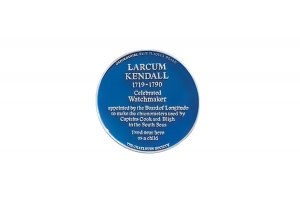
KENDALL - LONDON
WATCH MAKING IN THE 17TH & 18TH IN ENGLAND, AND LONGITUDE
During the 17th and 18th century, England was generally acclaimed as the greatest source of innovation in time pieces. The horologists of London were renowned for designing and producing high quality luxury watches and were pioneers in the development of highly accurate timepieces for maritime navigation, so called Chronometers, a crucial requirement for the survival of ships at sea. The watchmakers of London were organized as a Guild by Royal Charter of King Charles 1st in 1631 and known as the Worshipful Company of Clockmakers. Their remit (among others) was to oversee and ensure the quality of clock production throughout the 17th and 18th centuries – similar to the much later Federation of Swiss Watch Industry created in 1876.
THE DESIGN OF WATCHES IN THE 16TH AND 17TH CENTURY: A MATTER OF MALE FASHION
During the first half of the 17th century, clock watch design improved significantly, producing smaller models until, in 1666 a new trend was started by King Charles II of England, who introduced the waistcoat into formal wear and wore his watch in its pocket, thus the arrival of the “pocket watch.”
Pocket watches were expensive, elaborately decorated, hand-made works of art, owned and worn exclusively by the upper classes as status symbols. But the need for more accurate and reliable timepieces was becoming desperate among the major European maritime nations. England, France, Holland and Spain needed to find a way to determine the position of their ships at sea and accurate timepieces were the only way to correctly measure longitude. Among the great pioneers working to improve the accuracy and design of marine chronometers at the time was an Englishman named Larcum Kendall, born in 1719 at Charlbury (Oxfordshire).
FINDING THE LONGITUDE
Maritime History was littered with hundreds if not thousands of shipwrecks and naval disasters caused by navigators being unable to correctly identify their location. Finding a solution to the problem of longitude was a strategic and humanitarian necessity and triggered an international effort by scientists and navigators in Europe to find a way to accurately measure it. One can only determine one’s position on earth if one knows one’s Lattitude , i.e. how far one is north or south of the equator, and one’s Longitude, i.e. how far one has come round the earth (eastward or westward) from a specific reference point known as the prime meridian.
Meridians are imaginary lines that circumvent the earth passing through the poles and any given point on the earth’s surface can be identified by crossing its Meridian with its Latitude. The Prime Meridian is in Greenwich, South East London, and passes through the Royal Observatory of Greenwich.
King Charles II approved and encouraged the foundation of an academy of sciences called “The Royal Society of London for Improving Natural Knowledge” in his Royal Charter of 1663. One of its stated aims was “finding the Longitude.”
Many attempts were made by horologists and astronomers to solve the longitude problem, starting with Christiaan Huygens (amongst others), but more notably John Harrison, who designed a chronometer which allowed a viable assessment of the longitude of a ship at sea. Larcum Kendall followed in their footsteps and made the K1 which was famously tested by Captain James Cook on his ship the HMS Resolution during his second voyage of discovery.
THE LONGITUDE ACT OF 1714
In 1707 a fleet of four ships who lost their position ran aground on the Scilly Isles, and over 2000 men lost their lives. This brought the problem of accurately measuring the longitude of ships at sea into sharp focus. Under the Reign of Queen Anne, British Parliament passed the Longitude Act on the 16th June 1714 and the Longitude Board was established, made up of 24 Commissioners, whose purpose was to encourage research into the problem and offered a large reward for a provable solution to the issue of Longitude. It was not the first time that prizes were offered for the accurate determination of longitude at sea: in 1598 King Philip III of Spain offered 6000 ducats; the States-General of Holland offered a prize of 10.000 florins for the same purpose.
WATCH MAKING IN LONDON AND GENEVA
Towards the end of the 18th century, British watchmakers were producing the highest quality and most accurate timepieces in the world. Output reached 200,000 watches per year, about half of the world’s production and everybody wanted watches that were made in Britain. It wasn’t until after 1850 that the Swiss watch industry was able to surpass Britain as the world leader in watch-making, manufacturing a wide range of more fashionable products, from basic, highly affordable designs to more intricate, high quality watches.
